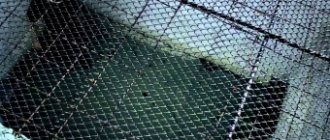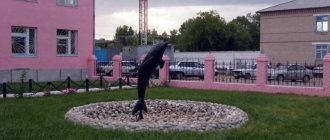Author: Natalya
15 August 2022 09:29
Tags: colonies, life imprisonment, prison terms
94860
27
According to the Federal Penitentiary Service, as of May 1, 2015, 1,914 people are serving life sentences in Russian correctional colonies. About a hundred more are serving a 25-year sentence instead of the death penalty, which was imposed before the moratorium but was not carried out. In the 1990s there were much more of them, but over the years many died in the colonies. In Russia, life-sentenced prisoners are held in five specialized institutions, each of which has a very romantic name.
0
See all photos in the gallery
Just like those sentenced to life: although there are no official statistics on mortality among them in open sources, according to unofficial data (such figures are given on forums for relatives of “inmates”), the average life expectancy of prisoners does not exceed 5-7 years. Remember the explosion of violent deaths after shootings first stopped in 1996? However, those who have at least somehow encountered places where life sentences are served in Russia unanimously declare that such punishment, as it occurs in our country, is much worse than a bullet in the back of the head. Of course, the issue is controversial, but let's look at how and where those sentenced to life imprisonment serve their sentences. Maybe SUCH a life, multiplied by the understanding that THIS IS FOREVER, is really harder than momentary pain and non-existence? Maybe this is what redemption should be like?
Early release
Parole for life-sentenced persons is assigned by the court, provided that the person has served in “places not so distant” for at least 25 years and does not require further imprisonment. The period may be calculated from the moment of detention as a preventive measure or the entry into force of a sentence. At the same time, the convicted person must not have had any malicious violations during the previous 36 months. If a prisoner committed a serious or especially serious act while serving his sentence, he does not have the right to be released on parole.
If a person has been denied parole, he has the right to re-apply only after three years.
Medicine
If a prisoner falls ill, he is examined by the prison doctor .
If necessary, a person is placed in a prison hospital ward or a separate cell for quarantine.
When surgery , a doctor from their city hospital is invited.
If there is a slight deterioration in health, the convict remains in the cell and is prescribed treatment. The tablets are fed through a small window on a special blade. Every prisoner undergoes a medical examination several times a year and can have his teeth treated .
In theory, a terminally ill prisoner is eligible for parole. Every year, medical commissions submit dozens of similar petitions. But so far none of them have been satisfied.
no exact statistics on how long criminals live . On average, life expectancy is 7-10 years. Some cannot accept their fate and go crazy or commit suicide.
But the percentage of these people is very small. The fact is that most criminals do not repent of their actions and do not feel guilty.
According to the law, after serving 25 years, a convicted person has the right to apply for parole. But so far not a single one has been released.
Firstly, only 150 prisoners managed to serve 25 years; secondly, in 25 years there should not be a single disciplinary sanction, but this is impossible.
Thirdly, according to psychologists, after 5-7 years a person’s personality in such conditions completely degrades , he gets used to living in the established regime and will no longer be able to adapt to normal life.
What crimes are punishable by life imprisonment?
Convicts receive the following punishment for life for the following acts:
1. Aggravated murder.
2. Hostage-taking or sabotage resulting in the intentional death of a person.
3. Encroachment on the life of a person who carried out a preliminary investigation, justice, law enforcement officer, public or government figure.
4. Terrorist act.
5. Genocide.
6. Actions related to the leadership, creation and organization of criminal gangs.
Content
In what conditions are such prisoners kept? The colony for life-sentenced prisoners has a special regime for serving their sentences. In such institutions they are kept separate from other criminals.
Life-sentenced prisoners are housed in cell-type premises. Usually no more than two people. A convicted person can also be kept in solitary confinement if there is a threat to personal safety. The decision to transfer to solitary confinement is made by the head of the correctional colony in the form of a resolution.
Convicts have the right to go for a walk every day. Its duration is one and a half hours. If the prisoner's good behavior is noted, the walk can be extended to two hours. Convicts are allowed to receive one parcel and one parcel or delivery during the year. During this period they can have two short-term dates. It is allowed to receive and spend a certain amount of money monthly to purchase basic necessities, food, etc.
For the first ten years, prisoners sentenced to life are kept under strict conditions. If during this time the prisoner has not received any penalties for violating the order, he is transferred to normal conditions of serving for another ten years. After this period, he has the right to easier conditions of detention.
Those sentenced to life have the right to self-education. The necessary conditions are created for this. They do not have the right to receive general education, and they are trained in vocational training for work in production.
How are the zones arranged?
Answering the question of how life prisoners are serving, it is worth saying that a special regime of detention has been created for special colonies. Prisons are located in remote places with a harsh climate and a strict security system. IR is closed to visitors.
In recent years, some prisons have undergone renovations and installed new equipment, which has partially improved living conditions.
Prisoners for life live in cells of two or three. They are distributed among cells taking into account psychological compatibility. Serial killers and pedophiles are kept in solitary confinement.
Have a question for a lawyer? Ask now, call and get a free consultation from leading lawyers in your city. We will answer your questions quickly and try to help with your specific case.
Telephone in Moscow and the Moscow region: +7
Phone in St. Petersburg and Leningrad region: +7
Free hotline throughout Russia: 8 (800) 301-39-20
In addition to the bed, each cell has a table and two chairs. All furniture is screwed to the floor. During the day you can only sit at the table, but not on the bed.
The lights are on in the cells around the clock, and every 15 minutes the prisoners are monitored through a peephole in the door. Even at night you cannot cover your head with a blanket and you need to sleep facing the door.
Due to the high location of the windows, they see daylight only when walking in the prison yard.
During daily searches, all prisoners are handcuffed and taken out into the corridor. The search is carried out with the help of sniffer dogs. In different ICs, conditions for walking around the territory may vary slightly. In some, movement around the prison territory is only possible in handcuffs, with your hands behind your back.
Where do life sentence prisoners sit?
There are currently five correctional colonies in Russia for such prisoners, the unofficial names of which are listed below.
1. “Black Dolphin” is a colony designed for one thousand six hundred convicts. Located in the Orenburg region, in Sol-Iletsk.
2. “Polar Owl” is located in the village of Kharp, Tyumen region in the Yamalo-Nenets district.
3. “White Swan” - built in Solikamsk, Perm Territory.
4. “Black Golden Eagle” - the colony is designed for two hundred places. Located in the village of Lozvinsky, Ivdelsky district, Sverdlovsk region.
5. “Vologda Pyatak” - located in the village of Novoozero on the Fire Island.
Where prisoners sentenced to life are imprisoned, separate special sections may be created. For example, one of them is located in Mordovia.
All colonies apply special security measures and are built in such a way as to exclude all possible escapes. Therefore, during the entire existence of the institutions, not a single criminal managed to escape from them.
“POLARY OWL” (Kharp village, Yamalo-Nenets Autonomous Okrug).
0
0
0
Correctional institution FBU IK-18 (old name OG 98/18) of the Federal Penitentiary Service of the Russian Federation for the Yamal-Nenets Autonomous Okrug “Polar Owl” is a special regime colony with a strict section. 400 people are serving life sentences. To serve their sentences, they send here mainly serial killers, repeat offenders, and other especially dangerous state criminals who have committed more than one particularly serious and cruel crime. The capacity limit for special regime penal colony No. 18 for holding those sentenced to life imprisonment is 1,014 places, including a high-security section for 450 places and a colony-settlement section for 100 places. The colony is geographically located in the urban-type village of Kharp (from the Khantean language - “Northern Lights”) of the Yamalo-Nenets Autonomous Okrug, Tyumen Region. Address: 629420, Yamalo-Nenets Autonomous Okrug, Priuralsky district, pos. Kharp, tel.: +7 (34948) 7-26-40, 7-29-73. Geographically, the village is located beyond the Arctic Circle on the border of the tundra and the Northern Urals. The village is located in a picturesque place, in a geographical zone called the Polar Urals, surrounded by mountains, on the banks of the Sob River. The buildings inside the zone are in very poor condition, but the village, on the contrary, looks quite decent. There are also five-story brick houses and cottages. The population is about 7 thousand people. The nearest city is Labytnangi. It is located 1920 kilometers from Moscow. You can get to Kharp by train (2 days on the way from Moscow) or by plane (3 hours flight from Moscow to the airport in Salekhard, then by passing vehicles to the crossing, from where the so-called “air cushion” follows through the Ob River to the village of Labytnangi » (in winter) or ferry (after the ice has completely disappeared), and from Labytnangi to Kharp - by passing car. Climatic conditions are quite severe - 5 months a year (from October to February), the average temperature is about - 40 ° C, the rest of the time from - 10° to -30°, ice melts from rivers and lakes at the end of May, summer lasts only one month - July. The village of Kharp is a regime village, formed in 1961 during the construction of Stalin's construction site No. 501. The village began as a camp for prisoners who built a railway. Subsequently, the camp was transformed into a special regime colony for especially dangerous repeat offenders. A correctional colony for those sentenced to life imprisonment - FBU IK-18 with the unofficial name "Polar Owl" (on the territory of the colony there is a monument to an owl, the wingspan of which is more similar to the imperial Orla) is the most geographically remote in Russia. The conditions for serving the sentence are no different from those above in the “Vologda Pyatak”. Here sit the policeman-killer Denis Evsyukov (who killed 2 and wounded 7) and the Bitsa maniac Alexander Pichushkin (who killed 40 people).
Basic rights
Those sentenced to life in Russia can count on receiving information from the colony administration about their rights and changes in the conditions or procedure of detention, as well as polite treatment from the colony staff. Prisoners should not be subjected to degrading treatment or punishment, except as provided by law. They are allowed to submit statements, complaints or proposals to the colony administration, the court, the prosecutor's office, the Commissioner for Human Rights, Children's Rights or the Commissioner under the President of Russia, etc. Correspondence is not prohibited. They can count on medical, psychological, social and legal assistance.
Creatures unsuitable for re-education How life-sentenced prisoners live and die in Russia
This message (material) was created and (or) distributed by a foreign media outlet performing the functions of a foreign agent, and (or) a Russian legal entity performing the functions of a foreign agent.
We need your help. Please support Meduza.
Prisoner of the life imprisonment colony "Mordovian Zone" in the Republic of Mordovia
Photo: Dmitry Lebedev / Kommersant
On November 17, the Constitutional Court of Russia allowed those sentenced to life to have long visits with their families. This is the first decision in the history of the country that at least slightly improves the lives of such convicts. Previously, long visits were allowed only after ten years in strict regime conditions - despite the fact that many life prisoners endure only a few years in such conditions and soon die. At the request of Meduza, the head of the human rights organization Zone of Law, Sergei Petryakov, explains how the existence of “lifers” works in Russia - and why the Constitutional Court decided to take pity on them.
After the verdict comes into force, it is usually no longer customary to write about those sentenced to life, although the stories of many of them thundered throughout the country. These are terrorists, serial killers, and crime organizers - just remember the Bitsa maniac Alexander Pichushkin, former member of the Federation Council Igor Izmestiev, Major Denis Evsyukov, the organizer of the neo-Nazi group BORN Ilya Goryachev and its key killer Nikita Tikhonov. There are also so-called political cases where the public doubts the fairness of the announced verdicts, as was the case with the former head of the internal economic security department of YUKOS, Alexei Pichugin. In addition, no one has canceled the potential percentage of banal miscarriages of justice.
Meanwhile, life sentences are not individualized in any way. Any resocialization or correction laid down in the general principles and official goals of the penitentiary system is completely excluded for life-sentenced prisoners. According to the FSIN - and so far it is supported by the majority of society - these people should “rot alive” without the possibility of ever being released.
Gone into the rut
In 1993–1999, 837 convicts, after the introduction of a moratorium on the death penalty, had their sentences commuted to life imprisonment. From 1997 to 2015, 1,354 life sentences were handed down in Russia. As of November 1, 2016, there were 1,984 people sentenced to life in Russia, and every year this number continues to grow.
Since the beginning of 2016 alone, the FSIN has recorded 29 newly arrived “lifers,” and in 2015, 68 such sentences were handed down. Just a month ago, as of October 1, the Federal Penitentiary Service reported 1,991 life sentences within its walls, and this is the absolute maximum for the current decade. The difference of seven people over the last month is either an indicator of mortality, or someone was transferred from colonies to pre-trial detention centers for the investigation of other criminal cases. Due to the closed nature of the prison system and similar statistics, it is not possible to establish this absolutely accurately.
According to some reports, some “lifers” who cannot come to terms with their fate live from three to seven years. If we subtract the number of people held in colonies from the sum of the announced sentences, we can approximately assume that about 200 lifers have died in Russia over these years. Among them, for example, is Brigadier General Salman Raduev, recognized by the court as a terrorist (died in 2002) and former assistant to the mayor of St. Petersburg Anatoly Sobchak, twice deputy of the city legislative assembly Yuri Shutov (died in 2014). From open sources it is also known about 15 suicides of “lifers” over the past ten years. In addition, there is such a term - “went into the rut”, that is, he became so immersed in himself and completely disconnected from reality that after some short time, without reacting to anything, he died.
Moreover, by the end of 2016, 150–185 such convicts will already have the legal right to parole (this right appears to those who have served 25 years from the date of their sentence). And by 2028, 1,298 “lifers” should have such a right. Not a single one has been released yet. According to the law, you can apply for parole again only after three years. In personal conversations, colony employees recall a special meeting held at the Federal Penitentiary Service three or four years ago about the fate of “lifers.” It was dedicated to the upcoming 25th anniversary of the punishment of the first of them - and the inevitable application for parole. The leadership of the Federal Penitentiary Service then gave the command not to release anyone until further instructions.
In case of incurable illness, these convicts have the right to be released for health reasons. Over the past ten years, special medical commissions, after a thorough examination, have sent 103 such petitions to the courts, but have not released a single one.
Conditions of detention
They are serving life sentences in six colonies, their unofficial names are familiar to many: “Black Dolphin” (Sol-Iletsk, Orenburg region), “Polar Owl” (Kharp village, Yamalo-Nenets Autonomous Okrug), “White Swan” (Solikamsk, Perm region), “Black Golden Eagle” (Lozvinsky village, Sverdlovsk region), “Vologda Pyatak” (Ognenny Island, Vologda region), “Mordovian zone” (Sosnovka village, Mordovia).
In the first ten years, “lifers” are entitled to one parcel or transfer and two short-term visits with relatives per year. Only for a few hours, under security, through glass and a telephone receiver - neither hug nor hold hands with your mother or wife. If suddenly someone still has social connections after ten years, two three-day long dates and two more packages or transfers per year are theoretically added to two short-term dates. After 20 years (again, very hypothetically) - three short-term, three long-term dates and four more parcels or packages and parcels.
There are two important circumstances that spoil this picture. Firstly, those sentenced to life for the first ten years are kept in special regime colonies under strict conditions; in order to switch to normal conditions that allow long visits after a decade, it is necessary not to receive any penalties from the administration. In reality, this is extremely difficult to do, and the sensational stories of Ildar Dadin are further confirmation of this. If you didn’t greet the employee, you got a penalty; if you didn’t have time to clean the cell, you got another punishment. But Dadin, according to the conditions, is far from being in a colony for life sentences. Secondly, by the end of the first ten years of the suspended death penalty, mothers die, wives start new families, and children are forgotten.
IK-6 of the Federal Penitentiary Service of Russia in the Orenburg region (“Black Dolphin”), where those sentenced to life imprisonment are serving their sentences
Photo: Marina Kruglyakova / TASS
The daily routine in the colonies for lifers is approximately the same. As a rule, getting up at six in the morning, exercising, cleaning, breakfast, work (if there is one or, most importantly, is generally allowed in the colony), lights out at 10 p.m.; You can’t sit down or lie down on the bed before it. Before bedtime, and even then not in all colonies and not every day, television with programs approved by the administration, board games, and letters to relatives are acceptable. 24-hour video surveillance and lights in the cells. Constant checks by duty officers at intervals of 15 minutes. Moving around an institution blindfolded to completely lose orientation in space. Life for years, two or four in one cell. This is a format of coexistence where even a father and son sentenced to life (and there are such cases; in the Black Dolphin alone there are seven families - brothers or father and son) after some long time persistently ask to be separated into different cells to avoid incidents; what can we say about strangers. There are, of course, solitary confinement cells, for example, this is where the murderer and cannibal Vladimir Nikolaev is kept.
The Shawshank Redemption
Over the past 25 years, Russia has been experiencing humanization and liberalization of the prison system. Thus, in November 2016, a new concept of criminal law policy was announced, according to which they want to limit the maximum term of imprisonment to 15 years. The institution of life punishment will remain, but the new concept will inevitably affect this category of convicts. If only simply because this institution, introduced for the first time in modern Russia 20 years ago - after the moratorium on the death penalty, unlike all the others, has never been reformed, and the time for change has inevitably come. The current mechanism neither de jure nor de facto objectively works. How can a person completely isolated from society be released on parole after 25 years? No matter how much he wants, he cannot be purely physically ready for this.
Once the authorities tried to completely deprive “lifers” of the right to ever be released by directly enacting such a ban. In the summer of 2014, draft amendments to the Criminal Code were introduced to the State Duma, which in principle prohibited life-sentenced prisoners from asking for parole. The reasoning is predictable: why “unwittingly condone” dangerous crimes, giving even a ghostly hope to those sentenced to life for freedom? This bill is still under consideration. However, it was in 2014 that the European Court assessed the lack of hope for early release and the resulting moral suffering as inhuman and harsh treatment (the case of Kharakchiev and Tolumov v. Bulgaria; before that, in Bulgaria there were two types of life imprisonment (PLS) - one with the right to parole, the second - without such a right).
But there is another way to avoid such discrimination. What is needed is a gradual and multi-stage system of resocialization, a potential return to a free life, in which, depending on the behavior in the colony, the punishment for such convicts will be individualized. If now life-sentenced prisoners are kept separately from everyone else, then individualization will initially (and in the case of positive dynamics) allow them to be kept together with other convicts. To imagine how this works, just remember the classic film “The Shawshank Redemption,” in which “lifers” are kept next to, for example, pickpockets. The next step may be changing the type of punishment to any other. And if the convict has completely reformed, we can talk about replacing the unserved part of the sentence with correctional labor or about real parole, for which, having gone through all the stages of the multi-stage system, the convict will be ready.
The practice is different now. Dreaming of freedom for years, those sentenced to life see that the number of those who have served 25 years has reached a critical level of 150 people - and that, despite the prescribed right, no one has actually been released on parole yet. There are already almost two thousand “lifers” in the country, and with each new and subsequent refusal of parole, their motivation drops and tension grows. What is the point of members of an organized crime group sentenced to life to give any testimony if they see that they will not have any chance of freedom even after 25 years?
“The conditions of detention for those sentenced to life imprisonment in most cases lead to personality degradation,” reports a comprehensive psychological study published in 2014 in the journal “Psychology and Law” of the Moscow State Psychological and Pedagogical University. “The majority of convicts regress irreversibly. Having become accustomed to a strictly regulated life routine, when his activity becomes completely suppressed from the outside, and issues of his life support are decided by the administration, he will most likely lose most of the skills for independent existence outside the walls of a correctional institution.”
The last penalty was dated 1991
In the “Mordovian zone,” 71-year-old former police major Pyotr Stakhovtsev is serving life imprisonment. On April 19, 1991, the Irkutsk Regional Court sentenced him to death with confiscation of property for robbery and murder committed during the Soviet era. He did not admit guilt, saying that he was a victim of a slander by the Irkutsk mafia and the heads of the Internal Affairs Directorate associated with it.
In 1985, Stakhovtsev himself headed the criminal investigation department in one of the districts of Irkutsk and worked as part of a task force that, on instructions from Moscow, checked the leadership of the Irkutsk police for involvement in illegal operations with timber, gold and omul. Then many heads of law enforcement agencies were fired, but the unscheduled Moscow inspection ended as suddenly as it began; Gradually, those who were caught and left returned to serve in the police, and Stakhovtsev was transferred from the criminal investigation department to private security. Later, as the court ruled, he became the organizer of the gang.
Until the 2000s, prosecution witnesses (including the main one, who was also serving a life sentence for the same crimes) wrote to various authorities - from the Chairman of the Supreme Court, the Prosecutor General to the President of Russia - that they were forced to incriminate Stakhovtsev.
On March 4, 1994, Russian President Boris Yeltsin pardoned Stakhovtsev by decree; The execution that never took place was replaced with life imprisonment. After 25 years spent in the colony, Pyotr Stakhovtsev filed a petition in court for parole. On March 16, 2016, the Zubovo-Polyansky Court of Mordovia refused to satisfy this petition.
Gennady Ilyakhin, sentenced to life, is being held in the Vologda Pyatak. His death sentence was announced on February 1, 1991, for attempted murder of a law enforcement officer. However, on October 20, 1993, by decree of Boris Yeltsin, the execution was replaced by life imprisonment. After serving 25 years behind bars, Ilyakhin applied for parole. The administration gave him a satisfactory reference. There are 19 rewards in the convicted person’s case, and the last penalty dates back to 1991 and was paid off long ago. “There is evidence of employment and housing in the event of release,” the documents stated.
However, on July 14, 2015, the Belozersky District Court of the Vologda Region denied Ilyakhin’s request. Six months later, Ilyakhin filed the same petition again, but on March 24, 2016, the court refused to accept this case, citing the fact that “lifers” can apply for parole only once every three years (unlike other convicts who can do this once every six months).
Also serving life imprisonment in the Vologda Pyatak is Vladimir Kornienko, who was sentenced to death by the Kursk Regional Court on December 7, 1990. By decree of the Russian President, it was replaced by life imprisonment. Kornienko was imprisoned since October 7, 1989, and 25 years later he prepared a petition for parole to the court. On July 14, 2015, the Belozersky District Court of the Vologda Region refused to satisfy this petition, despite all the positive characteristics and information about the availability of housing and possible employment.
Like Ilyakhin, Kornienko made a similar request for parole six months later and also received a court order refusing to accept this case, indicating that he could try again only after three years.
Special regime colony OG 98/18 “Polar Owl” (Kharp village). The abbreviation PLS on the clothes of the convicted person means “life imprisonment”
Photo: Yuri Tutov / PhotoXPress
Carbon-copy refusals
Convict Oleg Filatov is held in the Black Dolphin. On November 5, 1993, the Supreme Court of Udmurtia sentenced him to death. After a presidential pardon on December 21, 1998, his execution was commuted to life imprisonment. The time for parole has not yet come for Filatov (he served 24 years), and he decided to either replace the unserved part of the sentence with another type, or change the type of correctional institution. On June 17, 2016, the Sol-Iletsky District Court of the Orenburg Region refused to accept Filatov’s petition. The convict also lost the appeal - his complaint was left unsatisfied, and the decision of the first instance court entered into legal force.
After refusals of parole, Pyotr Stakhovtsev (“Mordovian Zone”), Gennady Ilyakhin and Vladimir Kornienko (both “Vologda Pyatak”) tried to use a substitute for punishment or a colony. And each of them received an answer as if it were a carbon copy, despite different regions and courts.
On May 24, 2016, the Belozersky District Court of the Vologda Region refused to accept Ilyakhin’s petition, stating that the rules on replacing the unserved part of the sentence with another type, or changing the type of correctional institution, cannot be applied to those sentenced to life. Pyotr Stakhovtsev received a similar response from the court in Mordovia on September 8, 2016.
Thus, the “lifers” were not helped by their advanced age, nor by the presence of good references from the administration, numerous incentives, lack of penalties, employment in production, absence of claims from victims - and the fact that their relatives were waiting for them at home. However, relatives of those sentenced to life are a completely different matter.
Right to visit
The story of the Korolev family is worthy of film adaptation. In 2008, Nikolai Korolev was sentenced by the Moscow City Court to life imprisonment to be served in a special regime colony. A year later, he had a wedding at Polar Owl. Veronica and Nikolai Korolev decided to have a child, and then it turned out that the next long date was legally possible only after ten years.
Until the end of 2014, the married couple visited the prison system with the involvement of officials and doctors. Since a long date without options was not allowed by law, the married couple decided on artificial insemination. There were no such opportunities in the Yamalo-Nenets Autonomous Okrug. The FSIN refused to transfer Korolev to a colony in another region where the IVF procedure could be performed. From November 2014 to 2016, the Korolev family went from a lawsuit in the Babushkinsky District Court of Moscow to the Constitutional Court of Russia, which, however, refused to consider this complaint.
In the Constitutional Court, the couple referred to the fact that this was a case of cruel and inhuman treatment and a violation of the right to family life. This argument seemed especially strong from the point of view of Veronica Koroleva, who, unlike her husband, was not even suspected of any crimes, but was forced to suffer.
Despite Korolev’s refusal in the Constitutional Court, already in June 2016, the Ministry of Justice of the Russian Federation prepared amendments to the Criminal Executive Code (regulates the life of prisoners), according to which life-sentenced prisoners should have the right to one long visit per year, even in high-security conditions in the first ten years to serve the sentence. In the explanatory note, the Ministry of Justice indicated that it developed this bill itself “in order to humanize the penal legislation.”
This act of humanism by the Ministry of Justice (if adopted) will establish a dating interval that is approximately 52 times less frequent than in 12 European countries. Thus, basically, life-sentenced prisoners in Austria, Belgium, Finland, Greece, Ireland, Malta, Montenegro, the Netherlands, Portugal, Slovenia, Spain and Switzerland can meet with relatives on a weekly basis. In some countries - Germany, Italy, Poland and the UK - the relevant documents specifically stipulate that the purpose of such dates is to maintain family ties.
The Korolev family is not the only one insisting on long visits for life-sentenced prisoners. At the same time, Olesya Matsynina sought such a right. She explained that her five-year-old daughter and her husband, who was sentenced for life, must see her father - during short-term visits, this is impossible through glass: “Our legislation offers us short-term, temporary visits. I can't take the child with me. I believe that this will be stressful for the child himself, because he will not be able to approach or touch his father.”
As a result, on November 17, 2016, it became known that the Constitutional Court of Russia nevertheless declared the ban on long visits in the first ten years of serving a sentence unconstitutional - and obliged to provide one such visit per year.
The basis for appealing to the Constitutional Court was laid by the decision of the European Court in the case “Khoroshenko v. Russia”. Andrei Khoroshenko was sentenced to death in Perm in 1995 (later commuted to life imprisonment) for banditry and murder. He defended his right to see his relatives more often in all instances since the early 2000s.
In 2015, the ECHR recognized this Russian practice as a violation of the right to private and family life. This was a unanimous decision of the Grand Chamber of the ECHR, that is, judges from all member countries of the Council of Europe. In its decision, the court indicated that nowhere are visits to convicts as restricted as in Russia, and referred to the experience of some other states that provide at least monthly long visits to convicts. At the ECHR hearing, representatives of the Russian authorities argued that “the goal of reintegration into society was not expected to be achieved in relation to those sentenced to life imprisonment” - and that “the isolation of such persons was the sole purpose of the corresponding conditions of serving the sentence.” In other words, the Russian authorities have shown that their goal is for lifers to die in prison.
The dissenting opinion of two ECtHR judges states: “The Russian state rejects any interest in human life other than the purely bodily survival of the prisoner, since the prisoner is subconsciously compared to a being unfit for re-education or for whom re-education is impossible. Figuratively speaking, a person sentenced to life imprisonment suffers a “civil death,” and life imprisonment is justified by the logic of “delayed execution,” which reduces the prisoner to the level of a mere object of influence of the executive power.”
Thus, we have to admit that only the European Court stopped the repressive trend against life sentences in Russia - and only now this trend is beginning to unfold.
"Jellyfish". We work 24/7. And only in the interests of readers. We urgently need your support.
I want to help
Sergey Petryakov
Moscow
Main responsibilities
Persons sentenced to life have the following duties:
1. Comply with legal requirements and regulations.
2. Comply with standards of behavior and sanitary rules.
3. Comply with the requirements of the administration of the colony and the bodies executing punishment that do not contradict the law.
4. Be polite to staff, prisoners and other persons visiting the institution.
5. They are obliged to appear when called by the administration of the colony and the bodies executing the punishment.
Emelevsky
An organized crime group led by Nikolai Emelyanov, known as the Emeli gang, has been operating in the Bryansk and Smolensk regions since the 90s. The brothers imposed tribute on businessmen, exterminated thieves in law and kept residents in fear - they could, according to locals, start a shooting in a restaurant or, in a drunken stupor, take away a car from a stranger. It was not immediately possible to attract authorities for the crimes: in 2015, the gang was acquitted - then, as it turned out, the jury was intimidated with death threats.
In 2019, criminals returned to the dock again. In addition to large fines, the accused received well-deserved sentences: “deputy” Emeli was sentenced to 23 years, the group’s killers were given 24 years and 19 years, and their assistant was given 18 years. Two high-ranking gang leaders will spend the rest of their days behind bars - Sergei Novgorodov and Igor Galantsev, nicknamed Gall, received life sentences.
Igor Galantsev - Gall
Emel himself has not yet been caught - when the businessman is captured, he will also face capital punishment.
Colony "Vologda Pyatak"
How are life-sentenced prisoners kept in this institution? Once a former monastery, and now the special regime correctional colony “Vologda Pyatak” is one of the toughest in terms of isolation and security. In the colony, those sentenced for life are kept with increased requirements and special restrictions.
Prisoners are kept two people in a cell, where during the day it is forbidden to lie down or sit on the bed. They wear special clothes. During walks, visits to toilets, bathhouses and other places, any contact with prisoners from other cells is excluded. All actions are performed exclusively with the permission or by order of the supervisor. Mass events - sporting competitions, professional and school training, film screenings are not held. Various investigative measures, for example, a search of a cell, are carried out under the supervision of at least three colony officers. Convicts are allowed short-term visits of a few hours. When taken out of the cell, the prisoner is handcuffed. In the colony, convicts are engaged in sewing mittens. For this purpose, there are special cells for two people.
"Polar Owl"
The official name is PKU IK-18 Federal Penitentiary Service of Russia for the Yamal-Nenets Autonomous Okrug (OG-98/18). One of the harshest colonies for keeping prisoners sentenced to life imprisonment, due to its geographical location (Kharp village of the Yamalo-Nenets Autonomous Okrug), received the unofficial name “Polar Owl”. It is the statue of this bird that is located at the central entrance to the institution. The decree on the creation of the colony was signed in 1973 and it was intended to support 600 people.
The contingent of the colony was initially used to work at the reinforced concrete products plant and in the construction of buildings, and since 1981, IK-18 began working as a correctional facility. In 2005, the Polar Owl was repurposed to house prisoners sentenced to life imprisonment.
Today, FGU IK-18 is capable of functioning autonomously and independently of the “mainland” . On the territory of the institution there are its own communal facilities: a boiler room, a diesel power station, a canteen, and a bakery. In addition, on the territory of the colony there is a car repair shop, areas for the production of reinforced concrete products, carpentry, marble, turning and sewing shops, and a shoe workshop. The prisoners themselves take part in ensuring the vital functions of all these facilities.
The labor of prisoners provides not only the needs of the colony itself, but also orders are accepted from organizations and enterprises located both in the Yamalo-Nenets Autonomous Okrug and in other regions. Currently it is designed to accommodate 1014 prisoners, of which about 400 are sentenced to life imprisonment.
As in other colonies for life sentences, in Polar Owl prisoners wear special clothing with the inscription “PLS” (life imprisonment) on the back and are kept in a separate building, in cells of two. When opening the cells, they are required to stand in a bent position with their arms extended back, palms with fingers spread behind their backs. This is followed by a long and most detailed listing of articles according to the court verdict.
All correspondence received by Polar Owl is illustrated in accordance with current Russian legislation.
Due to the fact that the colony contains many terrorists sentenced to various terms of imprisonment, control over the detention regime is carried out by officers of the Russian FSB.
Notable prisoners:
- Sergei Butorin – leader of the Orekhovskaya organized crime group;
- Alexey Voevodin – leader of the nationalist group “Combat Terrorist Organization”;
- Ilya Goryachev – leader of the nationalist group “Combat Organization of Russian Nationalists”;
- Denis Evsyukov is a former police major who committed a massacre in a Moscow supermarket in 2010;
- Nurpashi Kulaev is the only survivor of the attack on a school in Beslan in 2004;
- Alexander Pichushkin is a serial killer known as the Bitsevsky maniac.
Colony "White Swan"
How do life-sentenced prisoners live in this institution? The colony is designed for five hundred and ten people. She is a special regime institution and has seen more than one escape, each of which ended in failure.
In the cells of the colony, convicts are kept in groups of one, two or three people. The administration of the institution resettles them depending on psychological compatibility established by a professional psychologist. Prisoners are allowed to shower on Fridays and take one hour of exercise each day. Convicts are prohibited from working and studying.
The colony for life prisoners is equipped with trained dogs, powerful barriers, barbed wire and a fence. This rules out any escape options.
"Torbeevsky Central"
No photos. If anyone can provide it in good quality, please email
FKU IK-6 OUCD GUFSIN of Russia for the Republic of Mordovia (ZH-385/6). At its location in the village of Torbeevo, the Republic of Mordovia, it has the unofficial name “Torbeevsky Central”. It is one of the most closed prisons to the public and the press.
It only recently began to accept prisoners sentenced to life imprisonment. It is used mainly as a transit institution on the way of prisoners to places of permanent serving of their sentences, but the conditions of detention in it are no different from other institutions of this type.
The colony consists of three two-story buildings . Life prisoners are held in cells of one or two people. To avoid conflicts between cellmates, the administration resettles them based on their psychological compatibility. There is constant video surveillance.








